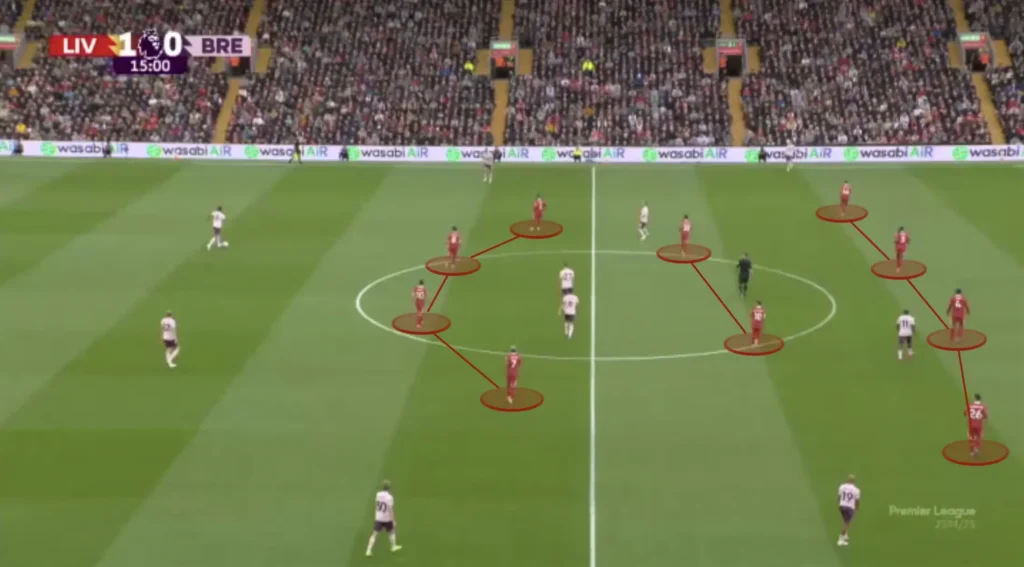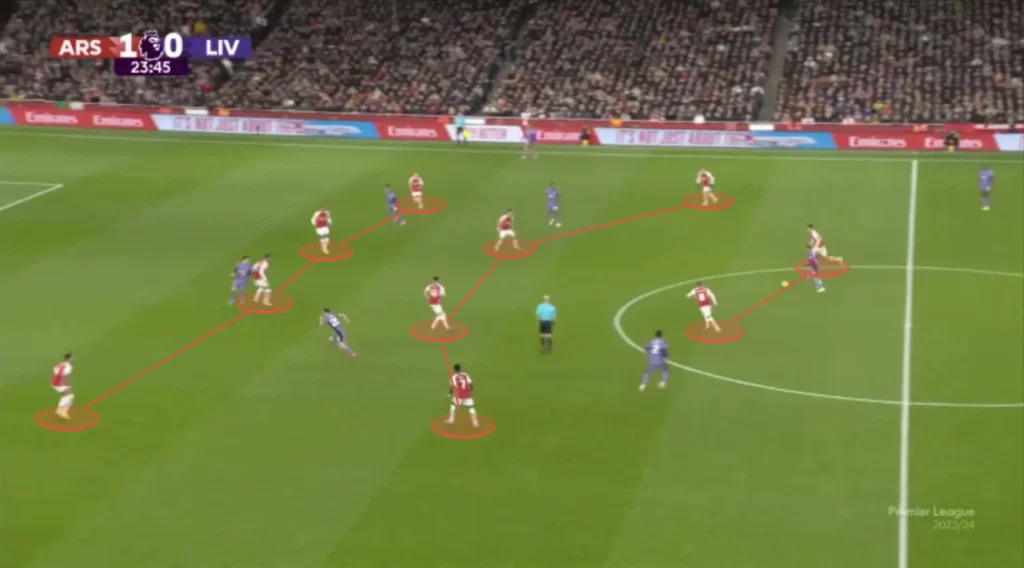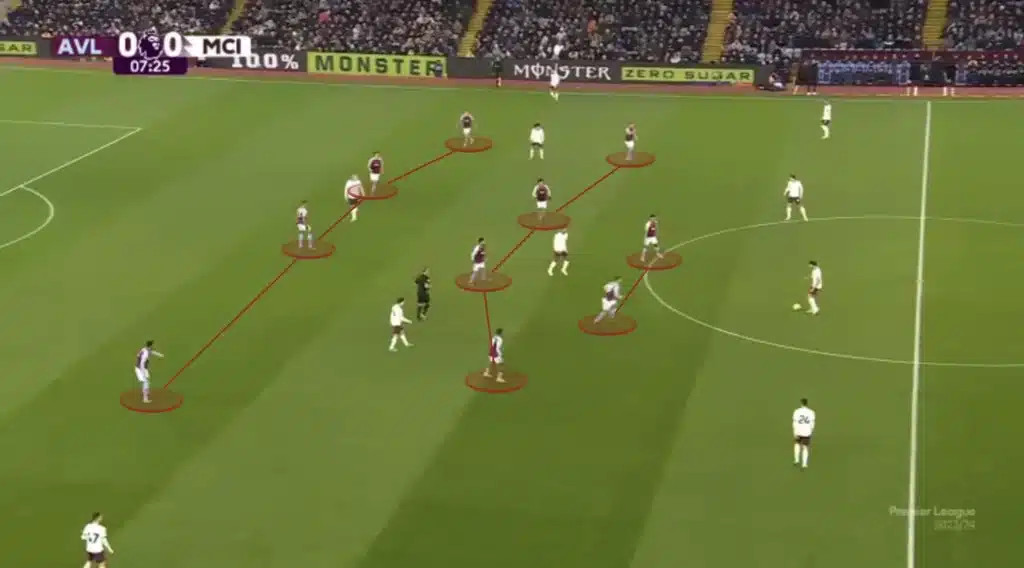The mid-block is one of the most common defensive tactics in modern football. It’s a strategy that balances the aggressive pressing of a high-block with the cautious nature of a low-block, positioning the team in the middle third of the pitch to control space, disrupt the opponent’s build-up, and prepare for quick counterattacks. Many elite teams use the mid-block and it works well against possession-heavy sides that rely on controlling central areas.
In this article, we’ll break down how the mid-block works, why teams use it, and its strengths and weaknesses. By the end, you’ll understand why this approach is so effective for staying compact, defending smartly, and creating counterattacking opportunities.
What is a Mid-Block?
A mid-block is a defensive system where a team organizes itself in the middle third of the pitch, with the defensive and midfield lines staying compact and coordinated. It aims to limit space in central areas, cut off passing lanes, and force the opposition to play in less threatening wide areas.

Unlike a high-block, where the team presses aggressively near the opponent’s goal, or a low-block, which sits deep near the penalty area, the mid-block occupies the space in between. It is designed to make life difficult for the opposition by reducing their ability to progress the ball through the center while leaving the defending team in a good position to transition into attack.
Key features of the mid-block include:
- Compact Shape: The team’s lines stay close together, reducing the gaps that opponents can exploit.
- Forcing the Opposition Wide: Players position themselves to deny central passes and channel the play into wide areas.
- Controlled Pressing: Pressure is applied selectively, often triggered by certain cues such as poor touches or predictable passes.
The mid-block is also a versatile strategy that suits various game situations. Teams often use it when facing opponents who dominate possession, as it limits their ability to create chances through the center. It’s also effective for teams looking to conserve energy, stay compact, and wait for the right moment to counterattack.
How Teams Use the Mid-Block
The mid-block is flexible and can be implemented in various formations, such as 1-4-4-2, 1-4-2-3-1, or 1-5-3-2. The choice of formation depends on the team’s style, personnel, and the opposition’s strengths.
Here’s how the structure typically works:
- Defensive Line: The backline positions itself just outside the penalty area or slightly higher, maintaining a solid shape to protect against direct balls over the top.
- Midfield Line: The midfielders are the heart of the mid-block, forming a compact line to block central passing lanes and support the defensive line.
- Forward Line: The strikers or attacking midfielders apply light pressure on the opposition’s defenders, primarily to guide the ball into wide areas rather than aggressively pressing.
A well-coordinated mid-block relies on strong communication and synchronized movements between the lines. When one player presses or steps forward, others adjust their positions to maintain the overall structure.
For example, Arsenal under Mikel Arteta has mastered the art of the mid-block. Their disciplined 1-4-4-2 structure makes it extremely difficult for opponents to break them down.

Similarly, Aston Villa under Unai Emery has used the mid-block to frustrate stronger teams and capitalize on counterattacking opportunities.

Key Tactical Principles
To understand the mid-block, it’s important to break down its tactical principles:
- Compactness: The team stays compact both vertically (minimizing the space between the lines) and horizontally (closing the gaps between players). This limits the opponent’s ability to play through the middle.
- Trigger Pressing: The mid-block often employs triggers for pressing, such as a backward pass, a loose touch, or an opposition player receiving the ball with their back to goal.
- Controlling Zones: Players are tasked with protecting specific zones rather than following opponents around the pitch. This zonal marking approach helps maintain the team’s shape.
- Transition Readiness: A mid-block is designed to position players effectively for counterattacks, with wingers and forwards ready to exploit spaces left by the opponent.
Advantages of the Mid-Block
The mid-block is a highly effective defensive approach for several reasons:
- Energy Conservation: Unlike a high press, which requires constant running and pressing, the mid-block allows players to conserve energy while maintaining defensive solidity.
- Control of Space: By staying compact in the middle third, teams can deny access to dangerous central areas and force the opposition into less effective wide zones.
- Defensive Stability: The mid-block provides a strong defensive foundation, making it difficult for opponents to penetrate through the lines.
- Counterattacking Opportunities: Teams in a mid-block are well-positioned to launch quick counterattacks when they regain possession, exploiting the spaces left by the opponent.
- Adaptability: The mid-block can easily transition into a high-block or a low-block, depending on the game situation.
Weaknesses of the Mid-Block
Despite its effectiveness, the mid-block is not without its vulnerabilities:
- Wide Areas: By focusing on central compactness, the mid-block often concedes space on the flanks. This can be exploited by teams with strong wingers or fullbacks who deliver dangerous crosses.
- Passive Pressing: The controlled nature of the mid-block means the opposition may have more time on the ball, which could allow creative players to find solutions.
- Precision Required: A mid-block relies on perfect coordination between players. A single error in positioning or communication can open gaps for the opponent to exploit.
- Risk of Long Shots: By allowing the opposition to hold possession in front of the block, teams that drop too low may be vulnerable to players capable of scoring from distance.
Conclusion
The mid-block is a key tactic in modern football, combining compact defense with counterattacking potential. By controlling the middle third, teams can frustrate opponents, protect key areas, and stay ready to attack.
While it requires discipline, coordination, and awareness, the mid-block is an excellent choice for teams seeking to frustrate their opponents while creating opportunities to strike on the counter. Its effectiveness has been proven time and time again by some of the best teams in the world.
Looking to expand your tactical knowledge? Explore more articles on defensive systems, attacking principles, and in-depth tactical analyses on our website!
